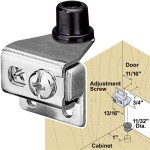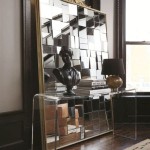Mounting Hardware for Frameless Mirrors: A Comprehensive Guide
Frameless mirrors, characterized by their clean edges and minimalist aesthetic, offer a modern touch to any space. Unlike framed mirrors, which rely on the frame for structural support and mounting, frameless mirrors require specialized hardware to be securely attached to walls. Selecting the appropriate mounting hardware is crucial for ensuring the mirror's stability, safety, and longevity. This article provides a detailed overview of the different types of mounting hardware available for frameless mirrors, factors to consider when choosing hardware, and best practices for installation.
The primary function of frameless mirror mounting hardware is to provide a secure and aesthetically pleasing means of affixing the mirror to a wall. The hardware must be strong enough to support the weight of the mirror without causing damage to the mirror itself or the wall. Additionally, the chosen hardware should ideally be discreet, minimizing its visual impact on the frameless design. Incorrect hardware selection or installation can lead to a variety of problems, including mirror instability, cracking, or even complete detachment from the wall, presenting a safety hazard. Therefore, careful consideration of mirror size, weight, wall type, and aesthetic preferences is essential when selecting and installing the appropriate mounting hardware.
Understanding Different Types of Frameless Mirror Mounting Hardware
Several types of mounting hardware are specifically designed for frameless mirrors, each with its own advantages and disadvantages. The most common types include mirror clips, mirror mastic, J-channels, and Z-clips, also occasionally referred to as French cleats.
Mirror Clips: Mirror clips are one of the most commonly used mounting options for frameless mirrors. These small, typically metal or plastic, brackets are attached to the wall and then used to hold the mirror in place. Mirror clips come in various styles, including adjustable clips, which allow for fine-tuning of the mirror's position after installation. Clips can be visible or concealed, depending on the design and placement. Visible clips are often chrome or brushed nickel, complementing the mirror's aesthetic, while concealed clips are designed to be hidden behind the mirror. The use of padded or rubber-tipped screws helps prevent damage to the mirror's edges. Mirror clips are suitable for small to medium-sized mirrors, offering a relatively simple and cost-effective mounting solution.
Mirror Mastic: Mirror mastic is a specialized adhesive designed for bonding mirrors to various surfaces, such as drywall, plaster, or wood. This adhesive is formulated to be non-corrosive and compatible with the mirror's backing. When using mirror mastic, it's crucial to apply it in vertical beads across the entire back surface of the mirror to ensure even weight distribution. While mastic provides a strong and permanent bond, it's essential to use it in conjunction with temporary supports, such as masking tape or shims, until the adhesive fully cures. Removal of a mirror attached with mastic can be challenging and may result in damage to either the mirror or the wall. It's important to select a high-quality mastic specifically designed for mirror installation and to strictly follow the manufacturer's instructions. Mirror mastic is often complemented with clips as a temporary support during the curing process or for added long-term security.
J-Channels: J-channels are metal or plastic profiles that are mounted along the top and bottom edges of the mirror. The mirror slides into these channels, providing a secure and visually appealing mounting solution. The J-channel at the bottom acts as a support, while the top J-channel holds the mirror in place. J-channels are typically made of aluminum or stainless steel, offering durability and resistance to corrosion. They are available in various finishes to match the mirror's aesthetic and the room's decor. J-channels are suitable for medium to large-sized mirrors, providing a clean and professional look. Careful alignment of the J-channels is essential during installation to ensure the mirror hangs straight and securely.
Z-Clips (French Cleats): Z-clips, also known as French cleats, consist of two interlocking metal brackets. One bracket is attached to the back of the mirror, while the other is mounted to the wall. The mirror bracket then slides down onto the wall bracket, creating a secure and concealed mounting system. Z-clips are particularly well-suited for larger and heavier frameless mirrors, as they provide excellent weight distribution and stability. The interlocking design allows for easy removal of the mirror for cleaning or maintenance. Z-clips are typically made of aluminum or steel, offering high strength and durability. Precise alignment of the brackets is critical for a successful installation. These are sometimes preferred for extremely large mirrors or mirrors in commercial settings.
Key Considerations When Choosing Mounting Hardware
Selecting the appropriate mounting hardware for a frameless mirror requires careful consideration of several factors, including the mirror's size and weight, the type of wall it will be mounted on, the desired aesthetic, and the ease of installation.
Mirror Size and Weight: The size and weight of the mirror are primary determinants in selecting the appropriate mounting hardware. Larger and heavier mirrors require more robust hardware to ensure stability and prevent detachment from the wall. Mirror clips are generally suitable for smaller, lighter mirrors, while J-channels and Z-clips are better suited for larger, heavier mirrors. When using mirror mastic, the weight of the mirror is crucially important to consider, as mastic strength alone may not be sufficient for very heavy mirrors. Always consult the manufacturer's recommendations for the weight capacity of each type of hardware. It is a good practice to oversize the hardware rather than undersize it.
Wall Type: The type of wall the mirror will be mounted on significantly impacts the choice of mounting hardware and the installation method. Drywall, plaster, concrete, and tile each require different types of anchors or fasteners. For drywall, using drywall anchors is essential to provide adequate support. For concrete or tile walls, drilling pilot holes and using appropriate screws and anchors are necessary. It's crucial to use hardware specifically designed for the particular wall type to ensure a secure and long-lasting installation. Failure to properly anchor the hardware to the wall can result in the mirror becoming unstable or detaching completely. When in doubt, consulting a professional installer is advisable.
Aesthetic Preferences: The desired aesthetic plays a significant role in selecting mounting hardware. Some homeowners prefer concealed hardware to maintain the clean, frameless look of the mirror, while others may opt for visible hardware that complements the mirror's design and the room's decor. Mirror clips are available in various finishes, such as chrome, brushed nickel, and black, allowing for customization to match the mirror's aesthetic. J-channels and Z-clips can also be selected in finishes that blend seamlessly with the surrounding environment. When using mirror mastic, the adhesive is completely concealed, providing the most minimalist look. The decision ultimately depends on individual preferences and the overall design of the space.
Best Practices for Installing Frameless Mirror Mounting Hardware
Proper installation of frameless mirror mounting hardware is critical for ensuring the mirror's stability, safety, and longevity. Following best practices during installation can help prevent common problems such as mirror instability, cracking, or detachment from the wall.
Accurate Measurement and Marking: Before installing any mounting hardware, precise measurement and marking are essential. Use a level and measuring tape to accurately determine the desired position of the mirror on the wall. Mark the locations of the mounting hardware using a pencil or marker. Double-check the measurements to ensure the mirror will be level and centered. Accurate marking ensures that the hardware is properly aligned, resulting in a professional and secure installation.
Proper Anchoring and Fastening: Selecting the appropriate anchors and fasteners for the wall type is crucial for providing adequate support. For drywall, use drywall anchors with sufficient weight capacity. For concrete or tile walls, drill pilot holes and use concrete screws or tile anchors. Ensure that the screws are tightened securely, but avoid over-tightening, which can damage the wall or the mounting hardware. Using the correct anchors and fasteners is essential for preventing the mirror from becoming unstable or detaching from the wall.
Using Protective Measures: When handling and installing frameless mirrors, it's important to take precautionary measures to protect the mirror from damage. Use gloves to avoid leaving fingerprints on the mirror surface. Place padding or cardboard under the mirror during installation to prevent scratches or cracks. When drilling into the wall, use a dust mask and safety glasses to protect yourself from debris. Taking these protective measures can help ensure the mirror remains in pristine condition during and after installation.
Professional Installation: For those unfamiliar with mirror installation or for larger, heavier mirrors, professional installation is highly recommended. Professional installers have the expertise and tools necessary to ensure a secure and aesthetically pleasing result. They can also provide valuable advice on selecting the appropriate mounting hardware and addressing any potential challenges. While professional installation may incur additional costs, it can provide peace of mind and prevent costly mistakes.

How To Hang A Frameless Mirror On The Wall With Pictures

How To Install A Mirror Without Frame Merrypad

Mirror Holder Clips Kit Clear Plastic Mounting Temu

4 Mirror Wall Hanging Mounting Fixing Kit Frameless Plastic Clips

How To Install A Mirror Without Frame Merrypad

How To Hang A Frameless Mirror On The Wall With Pictures

4 Mirror Wall Hanging Mounting Fixing Kit Frameless Plastic Clips
I Want To Install A Removable 16 Lb Frameless Mirror Without Any Hooks Showing Can Use Some Special Heavy Duty Glue Attach Wood The Back Of It And Then

Mirror Holder Clips Kit Clear Plastic Mounting Temu

4 Mirror Wall Hanging Fixing Kit Frameless Plastic Mounting Clips








